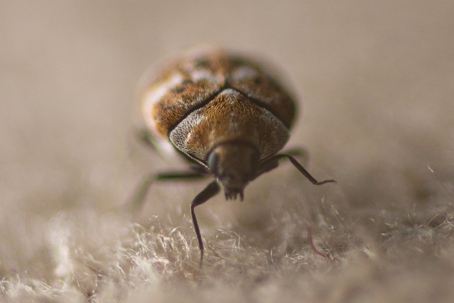Carpet Beetle Damage
Carpet beetles can cause significant and costly damage to both homes and businesses due to their larvae’s destructive feeding habits. While adult beetles typically feed on pollen and nectar and are harmless, carpet beetle larvae (often called “woolly bears”) feed on natural fibers and organic materials, leading to extensive material deterioration. Here are the types of damage carpet beetles can cause:
Damage to Fabrics and Textiles
Carpet beetle larvae are notorious for feeding on materials that contain keratin, a protein found in animal-based fibers. This includes:
Wool, silk, fur, leather, and feathers — resulting in threadbare patches or holes.
Upholstered furniture, rugs, draperies, and clothing — especially those stored for long periods.
Carpets and area rugs — particularly those made of natural fibers; they often eat from the underside, making damage less noticeable until it’s extensive.
Damage to Stored Goods
Carpet beetle larvae can infest stored fabrics, linens, and clothing in closets, attics, or storage boxes. In commercial environments such as museums, clothing stores, or warehouses, they can cause severe losses by damaging inventory, exhibits, and archival materials.
Contamination of Food Products
While rare, some species of carpet beetles can infest stored pantry goods such as grains, pet food, or dried plant materials. Their shed skins, droppings, and larvae can contaminate food supplies, leading to waste and potential health concerns.
Damage to Animal-Based Products and Taxidermy
Businesses that handle taxidermy, wool goods, or natural fabrics are at heightened risk. Carpet beetle larvae can destroy mounted animal specimens, museum artifacts, and feather-filled items, causing irreversible losses.
Hidden Structural Damage
Because carpet beetle larvae often develop in dark, undisturbed areas—such as behind baseboards, in air vents, or under furniture—they can cause hidden damage that goes unnoticed for months. Prolonged infestations can require costly replacements or professional remediation.
Carpet beetles pose a serious threat to property and inventory, particularly for homes or businesses containing natural fibers or organic materials. Prompt detection and professional pest control are essential to eliminate larvae, prevent reinfestation, and protect valuable belongings.
What Does Carpet Beetle Damage Look Like?
Carpet beetle damage is often subtle at first but becomes quite noticeable as the infestation progresses. The destruction is caused by carpet beetle larvae, not the adult beetles. These larvae feed on natural fibers and organic materials, leaving behind distinctive signs of feeding, waste, and cast skins. Here’s what carpet beetle damage looks like:
Irregular Holes or Bare Patches in Fabrics
Carpet beetle larvae chew unevenly through natural materials such as wool, silk, fur, feathers, leather, and cotton blends. Damage may appear as:
Scattered, irregular holes rather than clean-cut ones (unlike moth damage, which is more uniform).
Threadbare areas or bald spots on carpets, rugs, or upholstery.
Edges of fabrics fraying or thinning, especially on blankets, sweaters, or furniture.
Damage in Hidden or Undisturbed Areas
Larvae prefer dark, quiet places. You’ll often find damage:
Under furniture, along carpet edges, or behind baseboards.
Inside closets, drawers, or storage boxes where natural-fiber clothing or linens are kept.
In air vents or ducts, where lint and pet hair provide ideal food sources.
Contamination or Odor
In severe infestations, you might notice:
Powdery debris, fecal pellets, or lint-like material near the damaged area.
A musty odor or general deterioration of fabric integrity over time.
Carpet beetle damage looks like scattered holes and thinning fabrics. Early detection is crucial, as these pests can spread quickly and cause extensive, costly destruction to textiles, upholstery, and stored goods.
Where Is Carpet Beetle Damage Found?
Carpet beetle damage tends to occur in dark, quiet, and undisturbed areas—places where carpet beetle larvae can feed and develop without being noticed. Because these beetles are drawn to natural fibers and organic debris, their damage can appear almost anywhere such materials are present. Here’s where you’re most likely to find carpet beetle damage in homes and businesses:
Carpets, Rugs, and Flooring
Under furniture, along baseboards, or beneath area rugs, where vacuuming rarely reaches.
Edges of wall-to-wall carpeting, especially near radiators, air vents, or behind doors.
Underneath padding or floor coverings, where lint and hair accumulate unnoticed.
Carpet beetles often eat from the underside of rugs, making damage difficult to detect until it’s severe.
Upholstered Furniture and Fabrics
Under seat cushions, along seams, and on the backs or undersides of furniture.
Curtains, draperies, or wall hangings made of wool, silk, or other natural fibers.
Blankets, throws, and decorative pillows, especially those containing feathers, wool, or fur.
Closets, Storage Areas, and Drawers
Clothing, coats, and sweaters made from wool, silk, cashmere, or leather.
Stored linens, blankets, or seasonal clothing that hasn’t been moved or cleaned recently.
Dark corners of closets or sealed boxes, where larvae can thrive undisturbed.
Attics, Basements, and Crawl Spaces
Stored textiles, old furniture, or boxes of fabrics left untouched for long periods.
Animal nests or carcasses (e.g., rodents or birds) that provide food for larvae.
Insulation materials or cracks in flooring where debris collects.
Air Vents, Ducts, and HVAC Systems
Lint, pet hair, and dust buildup inside air ducts can provide ample food for larvae.
Damage may occur around vent covers or return air grills where debris accumulates.
Business and Commercial Locations
Museums, textile shops, and clothing retailers — at risk due to natural fiber goods and stored stock.
Hotels and offices — particularly in curtains, carpeting, and upholstered furniture.
Warehouses or storage facilities — where rarely disturbed inventory can become infested.
You are most likely to find carpet beetle damage where natural materials meet neglect—hidden, dark areas rich in lint, dust, or organic fibers. Regular cleaning, inspection, and our professional pest control are key to detecting and eliminating infestations before they spread.

